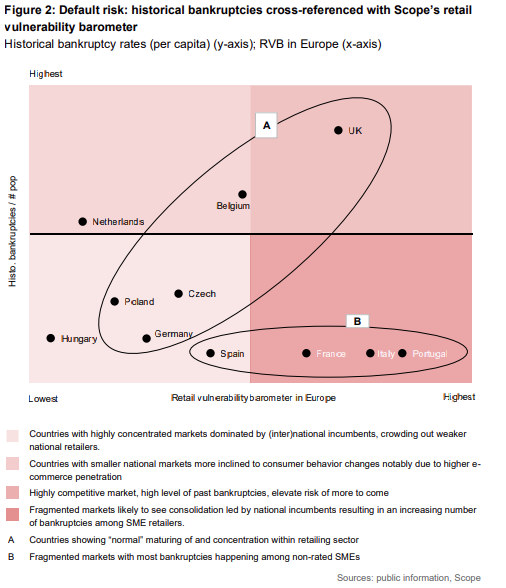Announcements
Drinks

Retailing bankruptcy risk grows in Europe: business failures to rise after slowdown in 2021-2022
“We expect an increase in the number of bankruptcies this year to levels close to those in 2019 and 2020 after a hiatus in 2021 and, to a lesser degree, last year,” says Adrien Guerin, analyst at Scope.
The sector, like others, has benefited from governments’ direct and indirect support during the pandemic and last year’s energy crisis. The impact is visible in the sharp decline in bankruptcies in the sector in 2021 compared with the previous year (Figure 1).
“However, government support is waning as cost-of-living pressures grow while e-commerce’s disruption of traditional retailing continues, all in the context of rising interest rates,” says Guerin.
Figure 1: Zombie effect: retail bankruptcies to rise as government support fades
Number of retail bankruptcies in Europe 2017-2022; short-, medium-term scenarios

Source: Scope Ratings
“The risks facing retailers today are spread unevenly across Europe, a phenomenon captured by our analysis of bankruptcy rates over the past six years and Scope’s retail vulnerability barometer (RVB),” says Guerin (Figure 2).
Scope compiles the RVB from several sources: data for per capita GDP to approximate purchasing power; the proportion of retailers paying on time and with a delay of at least 90 days to approximate their liquidity; and the World Bank’s logistics performance index as a measure of vulnerability to competition from e-commerce.
Multiple factors will determine how fast bankruptcy rates rise in the European retail sector in the years ahead. The varying level of government support for consumers and business will play a preponderant role, possibly influenced by pre-election government spending in individual countries.
Other factors such as changes to suppliers’ payment terms, penetration rates for e-commerce and overall purchasing power will play important roles, as captured in the RVB.

UK remains risky outlier; France, Italy, Portugal also high-risk, fragmented markets
The degree of country divergence is visible in Figure 2. Countries which score high in the RVB find themselves in the right-hand quadrants. “The bottom quadrant represents those countries where we expect to see consolidation in fragmented retail sectors as larger incumbents take advantage of failing small and medium-sized enterprises amid relatively difficult trading conditions,” says Guerin.
The intense competitiveness of the UK market ensures that retailers in the sector there remain vulnerable in line with high levels of defaults in recent past.
In contrast, the left-hand quadrants represent areas where bankruptcy risk is lower, such as in Germany (size of the market) and Hungary (regulation partially protecting the national players) where conditions favour local incumbents. The same applies to smaller economies such as Belgium, Czech Republic and Ireland where retailing has become more highly concentrated, reflecting the perhaps “natural” progression toward greater corporate resilience in the sector.






